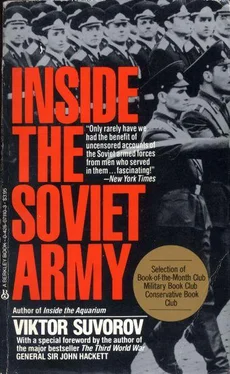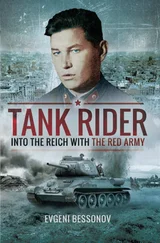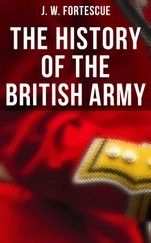Soviet requirements from a weapon are that it must be easy to produce and simple in construction, which makes it easier to teach soldiers to use it and simpler to maintain and repair.
Although the Soviet Union produced the same amount of steel as Germany, it built a much greater number of tanks. Moreover, because of the simplicity of their construction, it proved possible to repair tens of thousands of these tanks and to return them to battle two or even three times.
General Guderian admired Soviet tanks and wrote about them, enthusiastically and at length. He was insistent in urging that Germany should copy the T-34. The design of this Soviet tank was taken as a basis for the `Panzer' and shortly afterwards for the `Tiger-König'. But the German designers were unable to meet the most important requirement-simplicity of construction. As a result only 4,815 Panzer tanks were built in all, while no more than 484 `Tiger-König' tanks were ever produced. In the same period the Soviet Union built 102,000 tanks, 70,000 of which were T-34s.
In considering these figures it should be remembered that, while most German tank factories were subjected to bombing, many Soviet factories were lost altogether-the Kharkov plant was captured by the Germans in the first months of the war, and this was the largest Soviet factory and the birthplace of the T-34; the Stalingrad tank factory was the setting for the fiercest fighting it is possible to imagine. Leningrad was besieged, but, despite being without steel or coal, the tank factory there, which was subjected to constant artillery bombardment, continued to repair tanks for three years. On some occasions tanks which still were under repair had to be used to fire through gaps in the walls at advancing groups of German soldiers. The only factory that was left was in the Urals and it was to this that the machinery was taken and set up, virtually in the open air, to produce the world's simplest and most reliable tank.
It should not be thought that Soviet equipment suffers any harmful effects because of its simplicity of design. Quite the reverse. In its time, the T-34 was not only the simplest but also the most powerful tank in the world.
3
When a MIG-25 landed in Japan, the Western experts who examined it marvelled at the simplicity of its design. Naturally, for propaganda purposes, the fighting qualities of this excellent aircraft were disparaged. One not particularly perceptive specialist even commented, `We had thought it was made of titanium but it turns out to be nothing but steel. It is, in fact, impossible to reach the speeds of which the MIG-25 is capable using titanium: yet the Soviet designers had managed to build this, the fastest combat aircraft in the world, from ordinary steel.
This is a most significant fact. It means that this remarkable aircraft can be built without especially complicated machine tools or the help of highly skilled specialists, and that its mass-production in wartime would be unaffected by shortages of important materials. Furthermore, this aircraft is exceedingly cheap to produce and could therefore be built in very great numbers if this were necessary. This is its most important characteristic; the fact that for two decades it has been the fastest interceptor aircraft in the world, with the highest rate of climb, is of secondary significance.
4
Technology is developing and each year equipment becomes more and more complex. But this does not conflict with the overall philosophy of Soviet designers. Of course, decades ago, their predecessors used the latest equipment available in their combat vehicles and aircraft and this equipment must then have been considered very complex. But the iron, unbreakable principle observed by Soviet designers retains its force. Whenever a new piece of equipment is being developed, making the use of highly complex tools and techniques unavoidable, there is always a choice of hundreds, even thousands of possible technical procedures. The designers will always select the very simplest possible of all the choices open to them. It would, of course, be feasible to produce an automatic transmission system for a jeep, but it is possible to get by with an ordinary one. This being so, there can be only one Soviet choice-the ordinary transmission.
I once saw a film comparing a Soviet and an American tank. A driver was given both models to drive and he was then asked-`Which is the better? The American one, of course, said the driver. `It has automatic transmission, whereas in the Soviet tank you have to change gear, which is not easy in a heavy machine. He was quite right-if you see war as a pleasant outing. But Soviet designers realise that any future war will be anything but this. They consider, quite correctly, that, if there are mass bombing attacks, if whole industrial areas are destroyed, if long-distance communications break down, mass production of tanks with automatic transmission would be out of the question. Equally it would be impossible to repair or service tanks of this sort which had been produced before the war. Accordingly, there can be only one choice-the ordinary, non-automatic transmission. This may be hard on the tank driver-he will get tired. But it will be easier for industry and for the whole country, which will continue to produce tanks by the ten thousand on machines which have been set up virtually in the open air.
5
The simplicity of Soviet weapons surprises everyone. But each type of equipment which is produced is turned out in two variants-the normal one and the `monkey-model'.
The `monkey-model' is a weapon which has been simplified in every conceivable way and which is intended for production in wartime only.
For instance, the T-62 tank is one of the simplest fighting vehicles in the world. But as it was being designed, a still simpler version was also being developed, for wartime use. The `monkey-model' of the T-62 does not have a stabilised gun, carries simplified radio and optical equipment, the night-vision equipment uses an infra-red light source to illuminate targets (a method which is twenty years old), the gun is raised and turned manually, steel rather than wolfram or uranium is used for the armour-plating piercing caps of its shells.
Soviet generals consider, justifiably, that it is better to have tanks like these in a war than none at all. It is intended that the `monkey-model' approach will be used not only for building tanks, but for all other sorts of equipment-rockets, guns, aircraft, radio sets, etc. In peacetime these variants are turned out in large quantities, but they are only issued to countries friendly to the Soviet Union. I have seen two variants of the BMP-1 infantry combat vehicle-one which is issued to the Soviet army and another which is intended for the Soviet Union's Arab friends. I counted sixty-three simplifications which made the second `monkey-model' different from the original version. Among the most important of these were: The 73mm gun has no loading or round selection equipment. Whereas in the Soviet version the gunnerjust presses the appropriate buttons and the round which he requires slides into the barrel, in the simplified model all of this has to be done by hand, and furthermore, the gun is not stabilised. The turret is rotated and the gun is raised mechanically. In the Soviet version this is done electrically-the mechanical system is there only as a back-up. The `export' version is armed with the Malyutka rocket, the Soviet one with the `Malyutka-M', which differs from the other model in having an automatic target guidance system. The `monkey-model' is without the lead internal lining on the walls, which protects the crew against penetrating radiation and against flying fragments of armour in the event of a direct hit. The optical system is greatly simplified, as is the communications equipment, there is no automatic radiation or gas detector, there is neither an automatic hermetic sealing system nor an air filtration system, for use in conditions of very heavy contamination, no automatic topographical fixation system is fitted and many other systems are missing.
Читать дальше












